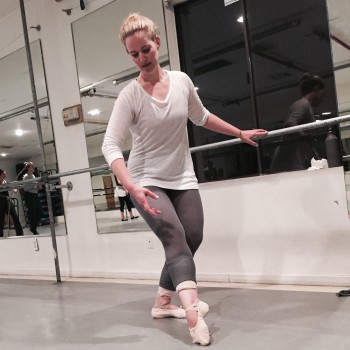Pennsylvania Ballet Principal Dancer, Lauren Fadeley, recently sat down with PopSugar to discuss her secrets for staying light on her feet and energized all day during dance rehearsals and performances
Posted by Adult Ballerina Project on Tuesday, June 23, 2015
PopSugar’s A Look at What A Ballerina Dancer Eats All Day
Body Positivity in the Classroom
 In the studio, we all want to do our best. We’re always looking in the mirror, trying to make our bodies do something new or challenging, and we’re always raising the standard for ourselves. It’s what makes us grow. Unfortunately, sometimes this feeling of ambition and expectation can make us feel inadequate. Sometimes we analyze our bodies so closely that we think there’s something wrong with us.
In the studio, we all want to do our best. We’re always looking in the mirror, trying to make our bodies do something new or challenging, and we’re always raising the standard for ourselves. It’s what makes us grow. Unfortunately, sometimes this feeling of ambition and expectation can make us feel inadequate. Sometimes we analyze our bodies so closely that we think there’s something wrong with us.
We talked body image with Katrina Errico, instructor and choreographer at Studio 19 Centre for Performing Arts in Eustis, Florida. She shared her experience with her own students and gave us some valuable advice about keeping a healthy attitude.
Is this a common issue among your students?
I see this a lot, especially with my teenage girls. For our adult students, we’re a lot more lenient with our dress code because we know how intimidating tights and a leotard can be. A lot of our adult students are women who have had children, haven’t danced in years or even have never danced before, and they don’t feel comfortable having their bodies on full display in class. If they can wear their favorite yoga pants and a tank top, they feel more secure and confident, and the experience can be about learning, not about comparing body types.
Why do you think we feel the need to compare ourselves?
Unfortunately, I think it’s natural to want to compare yourself. You’re in a room full of mirrors with a bunch of people you barely know, and you want to measure up. It can make you feel vulnerable — I don’t think there’s one of us out there who hasn’t looked at their body and wished they could change something about it.
Any tips for beginners or ballerinas intimidated by the big mirror?
- The most important thing to remember is that every single body is unique and special. Be grateful for the things your body can do for you, and recognize your unique talents. Maybe you’ve got a great extension, or a flexible back, or elegant epaulement. Whatever it is, your body is amazing for it.
- Compare yourself only to yourself; watch your progress and be proud of it. Don’t hold yourself to expectations meant for someone else’s body, and never talk down to yourself when you don’t get it right.
- Know your nutrition. Every successful ballerina knows that health comes first, and that a well-balanced meal is what your body needs to grow stronger between classes.
- Be patient with your body. Muscle tone and flexibility aren’t achieved overnight, and pushing yourself to rush the process can cause serious injury. We want healthy, happy bodies that can dance for a lifetime.
Image via Katrina Errico
Daydream Your Way to Success!
 In addition to physical practice, visualization can help you overcome those tricky steps
In addition to physical practice, visualization can help you overcome those tricky steps
Have you ever been stumped by a specific element of ballet technique? Perhaps you struggle with a bad habit, such as constantly looking at the ground while dancing. Maybe you dread a specific step in petit allegro, simply because you’ve consistently practiced but still can’t perform the step correctly.
Since dance is all about physical movement, practicing is the key to success. However, sometimes constant practice leads to stress and defeat. If a step is particularly tricky, practice can become tedious. However, there is a way to combat this frustration: visualization.
In her book, Dance Anatomy, Jacqui Greene Haas defines visualization as “creating a picture in your mind without doing the physical activity.” This method of practice requires no additional physical movement but includes positive, daydream-like focus on the step in your mind.
Visualization is easily executed, as long as you understand the technique of the step that is troubling you. Carefully watch the teacher in class as he or she performs the step, and if necessary, ask for the teacher to repeat the step. Be sure that you understand exactly what the body must do and which muscles create the movement.
Then, later in the day, spend time repeatedly imagining the step. Picture the teacher executing the step and then imagine how it would feel if you copied this movement. Imagine the muscle usage, studio surroundings from your vantage point, and musical rhythm. Continue this visualization technique for a few days. When you return to the step in class, keep a calm mindset and refer to the images you created while mentally focusing on the step. Generating positive feelings and decreasing stress, mental imagery will help you approach the step from a new perspective and lead you to success.
Expanding beyond a specific movement, this technique is extremely useful in my own career and helps me overcome the effects of stage fright. In some cases, when I was nervous about a specific role, I spent weeks prior to the performance imaging the character’s traits and expressions. In some cases, anxiety inspired by anticipated audience size or family or friend attendance may have inspired negative effects.
When I expected the presence of nervous butterflies flitting around in my stomach, I would prepare with mental visualization. Days before performing, I would imagine the intricate details; specific sections of choreography that I challenged me, the stage view of the full house, or a loved one’s face in the audience. I would increase the detail of my imagery, so that I would be absolutely prepared for the show. By repeatedly thinking ahead to the actual performance, I was able to transform nervous anxiety into bubbling energy. By mentally preparing myself, all the fears that may have overcome me during the performance became useful tools to enhance my dancing!
Whether you are performing for a crowd or enjoying a technique class, I encourage you to try the visualization method for yourself. You can read an excerpt of Haas’s book online.
Image via Flickr User Rodrigo Denúbila
Ballerina Profile: Laura of Surf and Hydrangeas
 When did you start doing ballet as an adult?
When did you start doing ballet as an adult?
February 2014, at 34 years old!?!
Did you ever take lessons as a kid?
No. My mom tried to sign me up for a session and I hated every second of it. All I wanted to do was jump around and I don’t think I even finished the classes – I was a kid with ants in my pants!
Why did you decide to take ballet as an adult?
I was looking for something to add to my strength training routine to mix it up a bit and I had been curious about ballet for a while. I wanted to see what real ballet training was like – it seemed like it would be a great challenge for me. {Being graceful has not historically been one of my strong suits! :-)}
Where do you take classes?
I take classes at Align Ballet Method in Los Angeles.
What is your favorite part about ballet?
I feel like the answer to this question changes every day! I’ve written a post about some of what I love, but so many times I come out of class and say “I loved that barre or combination today!” In general I think adagios and anything “pique” are my favorite parts of class.
What is your least favorite part?
I’m a pretty Type-A person and I get frustrated when things don’t come easily but I’m not a huge fan of frappes – they get me every time.
Who/What is your ballet inspiration?
I’m obviously in awe of pretty much every professional ballet dancer out there, but I find most of my inspiration closer to home. The Align Ballet Method teachers each bring their own style to class that inspires me to work on different parts of my dancing. I’m also constantly inspired by my classmates as well. They all have their own strengths that I’m in awe of and it pushes me to work harder.
What motivates you to keep dancing?
The constant challenge and my continued progress are what keep me motivated. It is amazing, and so much fun, to realize that I can do things I initially struggled with and to see how my dancing has developed over time. I also love that no matter how much I figure out there is ALWAYS something new to work on.
Do you take any other dance classes?
I only take ballet. But whenever I’m traveling for work or fun, I try to find studio to take a class in that city. So far I’ve taken classes in New York at a few studios, {Broadway Dance Center was by far my favorite} and Toronto at the National Ballet of Canada. Toronto was very cool since you are in the same building as the professional company!
What are your hobbies outside of ballet?
Ballet has definitely become #1 on my list in the last year but I also like photography and exploring LA. I try to go somewhere new once a week.
What advice would you like to give to those who want to start ballet or have just started?
Keep at it! It is frustrating, difficult and sometimes a little painful {I STILL get sore!} but don’t let a bad class discourage you. Everyone learns at their own speed and when things start to come together, it is totally worth it.
Anything else you’d like to add?
I was fortunate to be able to share my ballet experience on video not long ago and I hope that if anyone is nervous or not sure about taking ballet as an adult, my story helps them feel like this is something they can take on. It’s also really cool to have a record of my dancing so that next year {and beyond} I’ll be able to see my continued growth.
Do you have a blog?
Yes – Surf and Hydrangeas. It is more of a lifestyle blog, and not all about ballet, but I do write ballet related posts a couple times a month.
Adagio Tips from Ballerinas by Night
I’ve shared a lot of allegro tips lately, so here’s some adagio tips!

